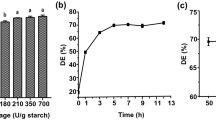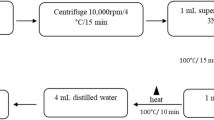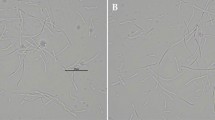Abstract
Curdlan is an extracellular polysaccharide produced by microorganisms with various applications in the food and biomedical fields. In order to reduce the cost of producing curdlan, the production of curdlan by Agrobacterium sp. DH-2 using sugarcane molasses as a carbon source was investigated. Pretreatment of sugarcane molasses reduced the metal content and resulted in an increase in curdlan production compared to untreated molasses. The composition of the medium based on pretreated molasses was optimized for curdlan production. The addition of (NH4)2HPO4 was found to be effective in increasing curdlan production, while the addition of corn steep liquor, CaCO3, KH2PO4, and MgSO4 did not have a significant effect. An orthogonal design was used to optimize the amount of (NH4)2HPO4 added and the sugar concentration of pretreated molasses. Maximum curdlan production of 13.0 g/L was obtained in the optimized medium, which contained a sugar concentration of 60 g/L of pretreated molasses and 1.0 g/L of (NH4)2HPO4. The curdlan produced in the molasses-based medium had an average molecular weight of 0.49 × 106 Da. FT-IR spectra and TGA thermal analysis showed that there were no significant differences between the curdlan produced and commercial curdlan. These results suggested that pretreated sugarcane molasses supplemented with (NH4)2HPO4 as a nitrogen resource could be used for economical production of curdlan.







Similar content being viewed by others
Data Availability
Data sharing not applicable to this article as no datasets were generated or analyzed during the current study.
References
Hu Y, Liu W, Yuan C, Morioka K, Chen S, Liu D, Ye X (2015) Enhancement of the gelation properties of hairtail (Trichiurus haumela) muscle protein with curdlan and transglutaminase. Food Chem 176: 115–122. https://doi.org/10.1016/j.foodchem.2014.12.006
Verma DK, Niamah AK, Patel AR, Thakur M, Sandhu KS, Chávez-González ML, Shah N, Aguilar CN (2020) Chemistry and microbial sources of curdlan with potential application and safety regulations as prebiotic in food and health. Food Res Int 133:109136. https://doi.org/10.1016/j.foodres.2020.109136
Basha RY, Kumar TSS, Doble M (2017) Electrospun nanofibers of curdlan (β-1,3 glucan) blend as a potential skin scaffold material. Macromol Mater Eng 302:1600417. https://doi.org/10.1002/mame.201600417
Belcarz A, Ginalska G, Pycka T, Zima A, Ślósarczyk A, Polkowska I, Paszkiewicz Z, Piekarczyk W (2013) Application of β-1,3-glucan in production of ceramics-based elastic composite for bone repair. Cent Eur J Biol 8(6):534–548. https://doi.org/10.2478/s11535-013-0169-2
Przekora A, Klimek K, Wojcik M, Palka K, Ginalska G (2017) New method for HA/glucan bone scaffold preparation reduces cytotoxic effect of highly reactive bioceramics. Mater Lett 190:213–216. https://doi.org/10.1016/j.matlet.2017.01.033
Ganbold T, Han S, Hasi A, Baigude H (2019) Receptor-mediated delivery of therapeutic RNA by peptide functionalized curdlan nanoparticles. Int J Biol Macromol 126: 633–640. https://doi.org/10.1016/j.ijbiomac.2018.12.152
El-Naggar ME, Abdelgawad AM, Salasb C, Rojas OJ (2016) Curdlan in fibers as carriers of tetracycline hydrochloride: controlled release and antibacterial activity. Carbohydr Polym154: 194–20. https://doi.org/10.1016/j.carbpol.2016.08.042
Ganie SA, Rather LJ, Li Q (2022) Review on anti–cancer and anti–microbial applications of curdlan biomaterials. J Polym Environ 30:1284–1299. https://doi.org/10.1007/s10924-021-02299-9
Fu Y, Cheng L, Meng Y, Li S, Zhao X, Du Y, Yin H (2015) Cellulosimicrobium cellulans strain E4-5 enzymatic hydrolysis of curdlan for production of (1→3)-linked β-D-glucan oligosaccharides. Carbohydr Polym 134:740–744. https://doi.org/10.1016/j.carbpol.2015.08.019
Shi Y, Liu J, Yan Q, You X, Yang S, Jiang Z (2018) In vitro digestibility and prebiotic potential of curdlan (1→3)-β-D-glucan oligosaccharides in Lactobacillus species. Carbohydr Polym 188:17–26. https://doi.org/10.1016/j.carbpol.2018.01.085
West TP (2020) Production of the polysaccharide curdlan by Agrobacterium species on processing coproducts and plant lignocellulosic hydrolysates. Fermentation 6: 16
Ben SR, Jaouadi B, Bouaziz A, Chaari K, Blecker C, Derrouane C, Attia H, Besbes S (2011) Fermentation of date palm juice by curdlan gum production from Rhizobium radiobacter ATCC6466TM: purification, rheological and physico-chemical characterization. LWT Food Sci Technol 44:1026–1034. https://doi.org/10.1016/j.lwt.2010.11.023
Wan J, Shao Z, Jiang D, Gao H, Yang X (2022) Curdlan production from cassava starch hydrolysates by Agrobacterium sp. DH–2. Bioprocess Biosyst Eng 45:969–979. https://doi.org/10.1007/s00449-022-02718-8
Mohsina A, J Sun, Khanc IM, Hang H, Tariq M, Tian X, Ahmed W, Niazic S, Zhuang Y, Chu J, Mohsine MZ, Rehmand S, M Guo (2019) Sustainable biosynthesis of curdlan from orange waste by using Alcaligenes faecalis: a systematically modeled approach. Carbohydr Polym 205:626–635. https://doi.org/10.1016/j.carbpol.2018.10.047
Guo X, Fu H, Feng J, Hu J, Wang J (2020) Direct conversion of untreated cane molasses into butyric acid by engineered Clostridium tyrobutyricum. Bioresour Technol 301:122764. https://doi.org/10.1016/j.biortech.2020.122764
Magalhaes AI, Carvalho JCD, Neto DPDC, Soccol CR (2020) Are sugarcane molasses competitive substrates for bio-based platform chemicals? J Agric Food Chem 68: 4073–4074. https://doi.org/10.1021/acs.jafc.0c01519
Palmonari A, Cavallini D, Sniffen CJ, Fernandes L, Holder P, Fagioli L, Fusaro I, Biagi G, Formigoni A, Mammi L (2020) Short communication: characterization of molasses chemical composition. J. Dairy Sci 103:6244–6249. https://doi.org/10.3168/jds.2019-17644
Zhang S, Wang J, Jiang H (2021) Microbial production of value-added bioproducts and enzymes from molasses, a by-product of sugar industry. Food Chem 346:128860. https://doi.org/10.1016/j.foodchem.2020.128860
Li Q, Zhou Y, Ke C, Bai Y, Liu X, Li S (2020) Production of welan gum from cane molasses by Sphingomonas sp. FM01. Carbohydr Polym 244:116485. https://doi.org/10.1016/j.carbpol.2020.116485
Tyagi B, Takkar S, Meena R, Thakur IS (2021) Production of polyhydroxybutyrate (PHB) by Parapedobacter sp. ISTM3 isolated from Mawsmai cave utilizing molasses as carbon source. Envir Tech Innov 24:101854. https://doi.org/10.1016/j.eti.2021.101854
Shukla P, Anand S, Srivastava P, Mishra A (2022) Hyaluronic acid production by utilizing agro–industrial waste cane molasses. 3 Biotech 12: 208. https://doi.org/10.1007/s13205-022-03265-5
Tyagi N, Suresh S (2016) Production of cellulose from sugarcane molasses using Gluconacetobacter intermedius SNT-1: optimization & characterization. J Clean Prod 112: 71–80. https://doi.org/10.1016/j.jclepro.2015.07.054
Küçükaşik F, Kazak H, Güney D, Finore I, Poli A, Yenigün O, Nicolaus B, Öner ET (2011) Molasses as fermentation substrate for levan production by Halomonas sp. Appl Microbiol Biotechnol 89:1729–1740
Pan NC, Pereira HCB, Silva MLC, Vasconcelos AFD, Celligoi MAPC (2017) Improvement production of hyaluronic acid by Streptococcus zooepidemicus in sugarcane molasses. Appl Biochem Biotechnol 182:276–293. https://doi.org/10.1007/s12010-016-2326-y
Alrefaey HMA, Abdel-Rahman MA, Hassan SED, El-Din MN, Azab MS (2021) Sequential optimization of the fermentation factors with integrating seed culture adaptation for increased biorefinery of beet molasses to lactic acid. Biomass Convers Bior 11:1013–1028. https://doi.org/10.1007/s13399-020-00773-3
Ai H, Liu M, Yu P, Zhang S, Suo Y, Luo P, Li S, Wang J (2015) Improved welan gum production by Alcaligenes sp. ATCC31555 from pretreated cane molasses. Carbohydr Polym 129: 35–43. https://doi.org/10.1016/j.carbpol.2015.04.033
Wan J, Wang Y, Jiang D, Gao H, Yang G, Yang X (2020) Effects of carbon sources on production and properties of curdlan using Agrobaterium sp. DH-2. Prep Biochem Biotech 50:857–864. https://doi.org/10.1080/10826068.2020.1777423
Kalyanasundaram GT, Doble M, Gummadi SN (2012) Production and downstream processing of (1→3)-β-D-glucan from mutant strain of Agrobacterium sp. ATCC 31750. AMB Express 2:31–31. https://doi.org/10.1186/2191-0855-2-31
Dubois M, Gilles KA, Hamilton JK, Rebers PA, Smith F (1956) Colorimetric method for determination of sugars and related substances. Anal Chem 28:350–356.
Kalogiannis S, Iakovidou G, Liakopoulou-Kyriakides M, Kyriakidis DA, Skaracis GN (2003) Optimization of xanthan gum production by Xanthomonas campestris grown in molasses. Process Biochem 39:249–256
Jo SY, Sohn YJ, Park SY, Son J, Yoo JI, Baritugo KA, David Y, Kang KH, Kim H, Choi JI, Rhie MN, Kim HT, Joo JC, Park SJ (2021) Biosynthesis of polyhydroxyalkanoates from sugarcane molasses by recombinant Ralstonia eutropha strains. Korean J Chem Eng 38(7):1452–1459. https://doi.org/10.1007/s11814-021-0783-7
Lee IY, Seo WT, Kim GJ, Kim MK, Park CS, Park YH (1997) Production of curdlan using sucrose or sugar cane molasses by two-step fed-batch cultivation of Agrobacterium species. J Ind Microbiol Biotechnol 18(4): 255–259. DOI: https://doi.org/10.1038/sj.jim.2900378
Wang B, Zhou X, Ren JL, Zhang MM, Wu QF, Yuan S, Liu W, Lu D (2022) Highly efficient utilization of sugar in molasses for butyric acid production by Clostridium tyrobutyricum. Sugar Tech https://doi.org/10.1007/s12355-022-01192-6
Dalsasso RR, Pavan FA, Bordignon SE, Aragão GMFD, Poletto P (2019) Polyhydroxybutyrate (PHB) production by Cupriavidus necator from sugarcane vinasse and molasses as mixed substrate. Process Biochem 85:12–18. https://doi.org/10.1016/j.procbio.2019.07.007
He X, Chen K, Li Y, Wang Z, Zhang H, Qian J, Ouyang P (2015) Enhanced L-lysine production from pretreated beet molasses by engineered Escherichia coli in fed-batch fermentation. Bioprocess Biosyst Eng 38:1615–1622. https://doi.org/10.1007/s00449-015-1403-x
Lee JH, Lee IY, Kim MK, Park YH (1999) Optimal pH control of batch processes for production of curdlan by Agrobacterium species. J Ind Microbiol Biot 23:143–148.
Wang Z, Li H, Feng J, Zhang A, Ying H, He X, Jiang M, Chen K, Ouyang P (2017) Enhanced succinic acid production from polyacrylamide-pretreated cane molasses in microbial electrolysis cells. J Chem Technol Biotechnol 93(3):855–860. https://doi.org/10.1002/jctb.5440
Saisriyoot M, Thanapimmetha A, Suwaleerat T, Chisti Y, Srinophakun P (2019) Biomass and lipid production by Rhodococcus opacus PD630 in molasses-based media with and without osmotic-stress. J Biotechnol 297:1–8. https://doi.org/10.1016/j.jbiotec.2019.02.012
Jung HI, Lee OM, Jeong JH, Jeon YD, Park K-H, Kim HS, An WG, Son HJ (2010) Production and characterization of cellulose by Acetobacter sp. V6 using a cost-effective molasses–corn steep liquor medium. Appl Biochem Biotechnol 162:486–497. https://doi.org/10.1007/s12010-009-8759-9
West TP. (2016) Effect of nitrogen source concentration on curdlan production by Agrobacterium sp. ATCC 31749 grown on prairie cordgrass hydrolysates. Prep Biochem Biotech 46(1):85–90. https://doi.org/10.1080/10826068.2014.985835
Banik RM, Santhiagu A, Upadhyay SN (2007) Optimization of nutrients for gellan gum production by Sphingomonas paucimobilis ATCC-31461 in molasses based medium using response surface methodology. Bioresour Technol 98: 792–797. https://doi.org/10.1016/j.biortech.2006.03.012
Zhu T, Zhu D, Li J (2020) A porous material made from curdlan by EDTAD functionalization shows high adsorption capacity on removal of Cu2+ and Zn2+ from water. J Polym Environ 28:1368–1377. https://doi.org/10.1007/s10924-020-01691-1
Gao M, Liu Z, Zhao Z, Wang Z, Hu X, Jiang Y, Yan J, Li Z, Zheng Z, Zhan X (2022) Exopolysaccharide synthesis repressor genes (exoR and exoX) related to curdlan biosynthesis by Agrobacterium sp. Int J Biol Macromol 205: 193–202. https://doi.org/10.1016/j.ijbiomac.2022.02.063
Mangolim CS, da Silva TT, Fenelon VC, do Nascimento A, Sato F, Matioli G (2017) Use of FT-IR, FT-Raman and thermal analysis to evaluate the gel formation of curdlan produced by Agrobacterium sp. IFO 13140 and determination of its rheological properties with food applicability. Food Chem 232:369–378. https://doi.org/10.1016/j.foodchem.2017.04.031
Acknowledgements
This work was financially supported by the Taixing Dongsheng Biotechnology Co. Ltd., China and the Natural Science Foundation of Shanghai (22ZR141200).
Author information
Authors and Affiliations
Contributions
Yanan Li: data curation and writing of the original draft. Jie Wan: investigation, methodology, and experimental work. Hongliang Gao: research plan, supervision, writing-review and editing. Xuexia Yang: conceptualization, editing of the manuscript, and funding acquisition. All authors reviewed the manuscript.
Corresponding authors
Ethics declarations
Conflict of Interest
All the authors declare that they have no conflict of interest.
Ethics Approval
Not applicable.
Additional information
Publisher’s Note
Springer Nature remains neutral with regard to jurisdictional claims in published maps and institutional affiliations.
Rights and permissions
Springer Nature or its licensor (e.g. a society or other partner) holds exclusive rights to this article under a publishing agreement with the author(s) or other rightsholder(s); author self-archiving of the accepted manuscript version of this article is solely governed by the terms of such publishing agreement and applicable law.
About this article
Cite this article
Li, Y., Wan, J., Gao, H. et al. Production of Curdlan by Agrobacterium sp. DH-2 Using Sugarcane Molasses-Based Medium. J Polym Environ 31, 4382–4392 (2023). https://doi.org/10.1007/s10924-023-02901-2
Accepted:
Published:
Issue Date:
DOI: https://doi.org/10.1007/s10924-023-02901-2




